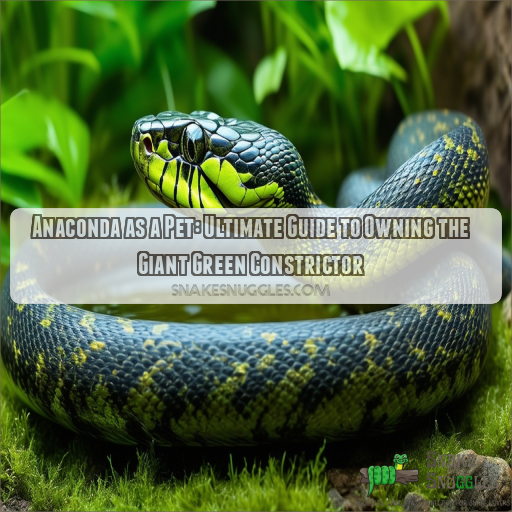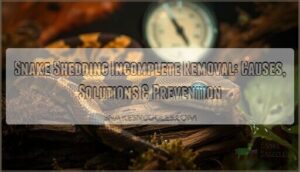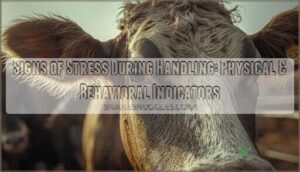This site is supported by our readers. We may earn a commission, at no cost to you, if you purchase through links.

These giants require a proper semiaquatic habitat, combining land and water areas. They also need a specific diet that changes as they grow—starting with mice for juveniles and moving to rabbits for adults.
Female anacondas are larger than males. Handling them requires early socialization and safety precautions, ensuring calm temperaments. Owning one is a long-term commitment, with green anacondas living 20-30 years. Ready to take the plunge and learn more?
Table Of Contents
- Key Takeaways
- Captive-bred Anacondas as Pets
- Enclosure Requirements for Green Anacondas
- Feeding Green Anacondas
- Legislation and Conservation
- Handling and Temperament
- Sexing and Breeding Green Anacondas
- Health Concerns for Captive Green Anacondas
- Enrichment and Behavior
- Choosing a Reputable Breeder or Seller
- Long-term Commitment
- Frequently Asked Questions (FAQs)
- Conclusion
Key Takeaways
- Anaconda ownership is not for the faint of heart. These massive snakes require specialized care and handling, so only experienced reptile enthusiasts should consider taking one on as a pet.
- Captive-bred anacondas are your best bet. They’re less likely to carry parasites or bacterial infections than wild-caught snakes, and they’re more likely to be accustomed to human interaction.
- Green anacondas are the largest species of anaconda. Females can grow up to 13 feet long, so you’ll need a lot of space to house one.
- Owning an anaconda is a long-term commitment. These snakes can live for 20-30 years, so you need to be prepared to provide them with proper care for their entire lives.
Captive-bred Anacondas as Pets
If you’re an experienced reptile owner considering an anaconda as a pet, captive-bred green anacondas offer a reduced risk of parasites and bacterial infections. Females of this giant semi-aquatic species grow substantially larger than males, reaching an average length of 11-13 feet.
Suitable for Experienced Owners
Owning a captive-bred anaconda, specifically the Eunectes murinus, is a task for those with experience handling large, constricting snakes. The significant anaconda size, especially with female dominance, demands an expert’s understanding of their behavior and needs.
Pet legislation often reflects the specialized care required, emphasizing the importance of early socialization and proper handling techniques to guarantee a safe environment for both the snake and owner.
Reduced Risk of Parasites and Bacteria
Captive-bred green anacondas offer the advantage of reduced risk of parasitic infections and bacterial issues compared to wild-caught counterparts . A key part of their care involves a proper diet, which should start with mice or rat pups for juveniles. Additionally, a well-maintained semiaquatic setup with appropriate water filtration guarantees your anaconda remains healthy and thriving.
Females Larger Than Males
When caring for captive-bred anacondas, you’ll notice females are notably larger than males, displaying remarkable sexual dimorphism. Females, reaching an average of 11-13 feet, outsize males, who average 7-9 feet.
- Growth rates vary with sexual maturity
- Dimorphic differences are conspicuous
- Size comparison shows females dominate
- Adapt enclosure for adult anacondas
- Understand reproduction strategies for amazing anacondas
Enclosure Requirements for Green Anacondas
To properly house a green anaconda, you’ll need a semiaquatic setup with ample land and water areas. Make sure your enclosure has a basking spot and a hide on land, while maintaining the water temperature between 76-82 degrees Fahrenheit, with adequate filtration to prevent bacterial growth .
Semiaquatic Setup With Land and Water Areas
Creating a proper semiaquatic setup is essential for your green anaconda’s health. Guarantee the enclosure has a two-thirds land area with suitable substrate options and live plants, maintaining appropriate humidity levels. The water basin should be large enough for submersion, with a cleaning regimen to prevent bacteria. Consistently monitor water volume and temperature between 76-82°F for ideal conditions [citations:1].
Basking Spot and Hide on Land
Creating a basking spot and hide for your green anaconda involves choosing appropriate substrate types to maintain suitable humidity levels. Include plant life for enrichment and implement security measures to prevent escapes. Clean the enclosure regularly and feed prey items like mice and jumbo rats. Providing these essentials helps keep your green anaconda healthy and thriving in captivity .
Proper Water Temperature and Filtration
To keep your green anaconda healthy, maintain water temperatures between 76-82 degrees Fahrenheit. Keep water depth adequate for submersion and guarantee a consistent heating system. Proper filtration and regular filter maintenance are critical to sustain water quality and prevent bacterial growth. Controlled humidity levels further contribute to a healthy environment for both juvenile and adult anacondas .
Feeding Green Anacondas
To keep juvenile green anacondas healthy, offer them mice or rat pups, gradually increasing prey size as they grow. Adult males do well on a diet of jumbo rats, guinea pigs, or small rabbits, while females thrive on medium to large rabbits .
Mice or Rat Pups for Juveniles
Feeding juvenile green anacondas involves offering appropriately sized prey to support their growth rate. Mice or rat pups are ideal due to their nutritional value and ease of ingestion. Set a consistent feeding schedule to ascertain your snake’s health and monitor its progress.
- Variety in prey types promotes desirable growth
- Use appropriately sized prey to prevent regurgitation
- Weaning from smaller to larger prey occurs naturally
Gradually Increase Prey Size
As your green anaconda grows, gradually increase the prey size to match its growth patterns. Start with small prey items, and adjust the feeding schedule accordingly. Larger prey items will provide essential dietary supplements, enhancing overall health. Provide prey availability and environmental enrichment for optimal development.
| Growth Stage | Prey Type | Frequency |
|---|---|---|
| Juvenile | Mice or small rats | Weekly |
| Sub-adult | Medium rats or weaned rabbits | Every 10-14 days |
| Near adult | Large rats or small guinea pigs | Every 14-21 days |
Adult Diet of Rabbits or Guinea Pigs
For adult green anacondas, offer a diverse diet, including rabbits or guinea pigs. Monitor prey availability and consider the ethical concerns of live prey versus frozen items. Supplemental options may be needed to guarantee a balanced diet. Always observe the snake’s health and adjust feedings accordingly to maintain proper weight and general well-being.
Legislation and Conservation
In the United States, legislation often restricts the captivity of green anacondas, largely due to misinformation about their behavior and needs. Responsible pet ownership is critical to ensuring that these magnificent reptiles can be kept safely and sustainably .
Restrictions on Captivity in the United States
When contemplating a green anaconda as a companion, you must navigate the intricacies of the exotic pet industry. Various states impose restrictions due to conservation efforts and legal implications. Ethical custodianship is paramount, as societal perception often influences legislation. Responsible pet ownership guarantees the well-being of these majestic creatures, supporting broader conservation initiatives .
Misinformation Can Lead to Restrictions
Misinformation about green anacondas often stems from their venomous reputation, which is misleading since they’re non-venomous. This can lead to harmful legislation. Misunderstandings about their impressive size, skin shedding, and dietary needs contribute to unnecessary fears. Furthermore, habitat destruction, population decline, and climate change aggravate these issues.
Key Points:
- Non-venomous nature.
- Misunderstood size and behavior.
- Impact of habitat destruction.
- Influence of climate change.
Responsible Pet Ownership is Crucial
Owning a green anaconda demands responsible pet ownership. Guarantee regular veterinary care to tackle health issues, and utilize effective socialization techniques from a young age.
Follow proper handling protocols to maintain safety for both you and your pet. Focus on enclosure aesthetics and provide enrichment options to mimic their natural habitat, encouraging their well-being and preventing behavioral issues.
Your commitment safeguards their conservation.
Handling and Temperament
Handling a green anaconda demands experience, as these snakes are calm when raised properly but can be difficult for inexperienced owners. Early socialization is essential to facilitate your anaconda becoming accustomed to being handled safely and confidently (Source).
Calm When Raised Properly
When you raise green anacondas properly, they’re surprisingly calm, displaying behaviors typical of their natural habitat differences. They’ve unique hunting techniques that require early socialization for them to adapt well to captivity. While lifespan comparisons show they live longer in care, breeding frequency still challenges owners. Wild population estimates also inform responsible handling and conservation efforts .
Not Suitable for Inexperienced Owners
Green anacondas, despite their calm nature when properly raised, aren’t suitable for inexperienced owners due to their size and strength. Handling them requires caution and knowledge. Here are four reasons why:
- Safety precautions are essential.
- Socialization techniques need expertise.
- Legal implications can be complex.
- Special insurance requirements might apply.
Understand these key factors before considering ownership.
Importance of Early Socialization
Early socialization is critical for a green anaconda’s temperament. Start with gentle Handling techniques to build trust and prevent defensive behavior. Observe body language closely; an anxious snake may hiss or constrict. Gradual exposure helps the snake bond with you, fostering a calm demeanor. Consistent interaction forms the foundation for a well-adjusted, manageable pet .
Sexing and Breeding Green Anacondas
When it comes to determining the sex of green anacondas, sexual dimorphism allows for the differentiation between the larger females and the smaller males. For accurate determination, you can use methods such as probing or DNA testing, although breeding these snakes in captivity poses significant challenges (Source).
Sexual Dimorphism in Size
In green anacondas, size difference due to sexual dimorphism becomes evident as they reach sexual maturity. Females, typically larger than males, can average 11-13 feet compared to males’ 7-9 feet . This difference affects breeding challenges, as larger females require more resources and space. Dimorphism causes include differential growth rates influenced by hormonal and ecological factors.
Determining Sex Through Probing or DNA Testing
To determine an anaconda’s sex, you can use techniques like probing or DNA testing. Probing involves gently inserting a probe into the cloaca to check for hemipenes in males. DNA testing requires a small tissue sample for lab analysis, providing accurate results.
These sexing techniques are essential for breeding programs and understanding the impacts of sexual dimorphism on your anaconda’s care .
Challenges of Breeding in Captivity
Breeding green anacondas in captivity comes with its fair share of challenges. Hatchling care requires diligence to prevent diseases. Inbreeding risks are significant, potentially reducing genetic diversity, impacting population robustness. Successful captive breeding often hinges on careful management and sometimes, tough decisions like considering euthanasia.
Here are three essential considerations:
- Ensuring robust genetic diversity.
- Managing health and diseases.
- Planning for ethical outcomes.
Health Concerns for Captive Green Anacondas
To maintain your pet Green Anaconda’s health, you’ll need to monitor for common issues like parasites, bacterial infections, and respiratory problems. Adequate care, including clean water and suitable temperatures, is essential for preventing these health concerns .
Parasites and Bacterial Infections
Parasite prevention and bacterial transmission are essential in maintaining the well-being of captive green anacondas.
Establish effective health monitoring and promptly address any irregularities.
Implement rigorous quarantine protocols for new arrivals and seek regular veterinary care.
Proper enclosure hygiene, including maintaining clean water and substrate, is paramount to prevent the spread of infections.
Regular health checks can detect issues early, guaranteeing the health and prosperity of your anaconda.
Respiratory Issues
Respiratory infections are a common health concern for captive green anacondas and can develop due to improper enclosure conditions. Symptoms often include lethargy, wheezing, and excess mucus.
To prevent these issues, maintain proper humidity levels, ensure good ventilation, and keep the water clean to avoid fungal infections and skin problems.
Regularly monitor your snake for signs of illness to catch issues early.
Importance of Proper Husbandry
Proper husbandry is essential for green anacondas to thrive in captivity. Ensuring their health and longevity involves:
- Breeding Legality: Always comply with local regulations to prevent legal issues and guarantee ethical practices.
- Health Risks: Regular check-ups to minimize parasites, bacterial infections, and respiratory issues.
- Socialization Techniques: Gently handle young anacondas to foster calm behavior, reducing stress and promoting a healthy captive lifespan.
Enrichment and Behavior
To keep your green anaconda healthy and content, it’s essential to provide mental stimulation through activities like climbing and swimming. Observing their natural behaviors in captivity helps verify they’re getting the enrichment they need to thrive .
Providing Mental Stimulation
To provide mental enrichment for your green anaconda, integrate habitat construction with various textures, hiding spots, and objects to explore. Offer cognitive stimulation through puzzle feeders and varied prey presentations. Sensory stimulation can include scent trails or introducing safe items with different smells. Regularly observe your anaconda’s behavior to guarantee it’s engaging with the environment and make adjustments as needed (Source).
Climbing and Swimming Opportunities
To enrich your green anaconda, provide climbing opportunities with sturdy branches and a swimming enclosure featuring water at appropriate depths and temperatures. These elements mimic their natural habitat, offering essential physical and mental stimulation. Engage your anaconda with varied enrichment activities that encourage exploration and exercise. An effective setup guarantees they remain active, healthy, and exhibit natural behaviors.
Observing Natural Behaviors in Captivity
Ensure your green anaconda thrives by monitoring water quality closely. Maintain both temperature and filtration systems to avoid bacteria buildup. Provide varied basking spots to observe basking preferences, and guarantee hides are offered for security.
Encourage swimming behavior with ample water space, and stimulate natural climbing behaviors by including sturdy branches. This setup enriches your pet’s environment while allowing their natural behaviors to flourish .
Choosing a Reputable Breeder or Seller
It’s crucial to select a reputable breeder or seller to obtain a captive-bred anaconda, guaranteeing a healthier, more manageable pet. Steer clear of wild-caught specimens, as they often harbor parasites and stress-related issues .
Importance of Captive-bred Animals
Choosing captive-bred green anacondas is essential for responsible pet ownership. Captive-bred animals exhibit more predictable anaconda behaviors, reducing the need for challenging captures. Besides, these snakes have fewer parasites, which lowers health risks during their care and captive hibernation. To guarantee compliance with breeding legality, always select reputable breeders. Here’s how to do it:
- Verify the breeder’s credentials and reviews.
- Confirm they follow proper diet diversity and care protocols.
- Inspect their facilities for appropriate enclosure enrichment.
- Ensure they comply with local breeding regulations and conservation efforts.
Choosing wisely fosters better anaconda care and conservation.
Avoiding Wild-caught Specimens
Avoiding wild-caught specimens is essential due to the importing risks of zoonotic disease transmission, which can affect both humans and other animals .
Ethically, capturing wild green anacondas disrupts ecosystems and harms conservation efforts. By choosing a reputable breeder, you support ethical practices and reduce negative conservation impacts.
Public perception of exotic pet ownership can be controversial, and choosing captive-bred anacondas shows responsible pet ownership, promoting positive attitudes. Verify sellers provide proper documentation and health records to avoid potential issues. This approach helps guarantee a healthier, more manageable pet and contributes positively to the species’ future.
Long-term Commitment
Owning a green anaconda requires a serious long-term commitment, as these snakes can live 20-30 years. To guarantee their well-being, you’ll need to provide consistent and proper care throughout the animal’s lifetime.
Green Anacondas Can Live 20-30 Years
Green anacondas can live 20-30 years in captivity, so be prepared for a long-term commitment. Providing proper habitat size, dietary supplements, and care is essential for their longevity. Anacondas need specific handling techniques to ensure both your safety and the snake’s health. Here are key points to keep in mind:
- Habitat Size: Ensure a large enclosure with both land and water areas.
- Dietary Supplements: Maintain a balanced diet with necessary supplements.
- Handling Techniques: Learn and apply safe handling practices.
- Hibernation Needs: Understand and accommodate their seasonal requirements.
Taking these steps helps ensure your anaconda’s well-being over the decades.
Ensuring Proper Care for the Animal’s Lifetime
Guaranteeing proper care for your green anaconda throughout its lifetime demands commitment and attention to detail. Regularly monitor water quality, maintain correct enclosure dimensions, and provide enrichment activities. Promoting healthy socialization strategies will make handling easier and stress-free. Use these core areas to guide your efforts:
| Aspect | Key Points |
|---|---|
| Handling Techniques | Gentle, consistent, early socialization |
| Enclosure Dimensions | Spacious, semi-aquatic setup essential |
| Water Quality Monitoring | Regular checks and filtration for hygiene |
| Enrichment Activities | Climbing, swimming areas, mental stimulation |
Your dedication ensures a thriving, well-adjusted anaconda.
Frequently Asked Questions (FAQs)
What kind of health checks are needed?
Regular health checks for green anacondas should include parasite screenings, weight monitoring, shed quality, skin integrity, hydration levels, and fecal exams. These guarantee your snake remains healthy and vibrant, mitigating any potential issues early.
Can green anacondas live with other pets?
Green anacondas can’t live with other pets as they can see them as prey. Their size and strength pose a risk, making it unsafe to house them with other animals in a domestic setting.
How do green anacondas behave in social scenarios?
Breeding season sees green anacondas forming "breeding balls," where multiple males coil around a single female, competing for mating rights. Outside this period, they’re solitary, favoring minimal interaction with other anacondas .
Which climates are best suited for green anacondas?
Green anacondas thrive in humid, tropical climates found in South American regions like the Amazon Basin, supporting their need for warm temperatures (76-82°F), abundant water, and dense vegetation for shelter and hunting .
What are the signs of an unhealthy green anaconda?
Signs of an unhealthy green anaconda include lethargy, lack of appetite, abnormal stool, unusual swelling, respiratory issues like wheezing or gasping, skin shedding problems, mites, and unusual aggression or docility. Immediate veterinary attention is critical.
Conclusion
Imagine the monumental responsibility of owning an anaconda as a pet. It’s not just a reptile, but a semiaquatic giant requiring specialized care.
Prioritize breeding anacondas in captivity to minimize health risks. Their habitat should provide a balance of land and water areas, with feeding routines adjusted as they mature.
Familiarize yourself with legal regulations, potential health concerns, and the significance of early socialization. This substantial commitment demands dedication but offers a gratifying experience for experienced reptile enthusiasts.






